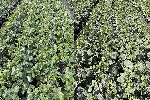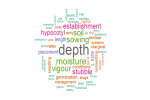Soils with gravel mulches have produced higher-yielding crops than those deep-ripped or treated with gypsum in field trials that are evaluating ways to ameliorate Western Australia’s difficult sodic and alkaline soils
Gravel mulch is emerging as a new way to improve the productivity of heavier soils in the low-rainfall zone of Western Australia’s eastern wheatbelt.
The technique is being trialled as part of a five-year GRDC investment with the WA Department of Primary Industries and Regional Development (DPIRD) to evaluate techniques to ameliorate sodic and alkaline soils.
Figure 1: Location of three gravel mulch trial sites – Devils Creek, Mooring Rock and Grass Patch.

Source: Coretext
The research project follows on-farm experiments by Ravensthorpe grower Peter Dawe and glasshouse trials by DPIRD researcher David Hall, which demonstrated that gravel or mineral mulches can reduce water evaporation and potentially improve yields.
The project manager for the soil amelioration trials is DPIRD senior research soil scientist Wayne Parker.
He says the aim is to find new and effective ways to improve yield consistently on the strong, heavier soils. Target soils are highly sodic (exchangeable sodium percentage higher than six per cent of total cations) and highly alkaline (pH 8.1 or more), which leads to dispersion and surface crusting. They have clay content greater than 20 per cent, do not allow easy access to stored water and can be high in boron.
Mr Parker says 11 treatments, with a nil control, are being trialled at three farm sites: Devils Creek (Mullewa), Moorine Rock (Merredin) and Grass Patch (Esperance) (Figure 1).
Treatments include:
- gypsum at 100 kilograms/hectare applied in-furrow with seed;
- gypsum at three tonnes/ha applied on the surface prior to sowing;
- deep ripping with a slant tyne ripper prior to sowing, alone, and in combination with each of the gypsum treatments;
- gravel mulch 3.5 centimetres deep spread prior to sowing;
- gravel mulch in combination with each of the gypsum treatments;
- gravel mulch in combination with deep ripping; and
- gravel mulch in combination with deep ripping and each of the gypsum treatments.
Yield results
Over three years of trials, only gravel mulches have provided significant yield improvements, and only at trial sites where seasonal conditions meant that moisture was a limiting factor for crop growth. By preventing evaporation, gravel mulches have made more water available to crops.
The 2022 growing season rainfall ranged from 209 to 367 millimetres, with one of the longest and coolest seasonal finishes on record. The 2023 season had lower growing season rainfall (111 to 176mm) with a warm to hot finish. In 2024, the growing season was short with higher rainfall of up to 409mm, most of which fell in June and July, followed by a very dry finish.
In 2022, wheat was planted at all sites and the gravel mulch treatment (main effect) increased grain at Devils Creek by 20 per cent over the untreated control plot and by 98 per cent at Moorine Rock.
In 2023, wheat was again planted as the trial crop at all sites. The gravel mulch treatment increased the yield over the control plot by 37 per cent at Devils Creek and 179 per cent at Moorine Rock.
In 2024, barley was planted at Moorine Rock, with a positive yield response of 80 per cent in the gravel treatment. A third season of wheat at Devils Creek showed a positive response of four per cent.
In 2024, barley was planted at Grass Patch after two seasons of wheat. However, there was no significant response in any year at this site, where higher levels of soil moisture meant water was not generally a limiting factor in grain production.
Figure 2: Yields of control (untreated) versus mulched crop yields from three trial sites, 2022–24.

Source: DPIRD
Gypsum inconsistent
Mr Parker says adding calcium, in the form of gypsum, is the conventional treatment to address chemical constraints in these soils. It also reduces pH and can further reduce dispersion.
“But we’ve found that the response to gypsum is inconsistent across paddocks with these kinds of soils. We’re still investigating the mechanisms and soil chemistry to understand why that is.
“In the trials, we weren’t able to get a significant response to gypsum at the rates we applied.”
The gravel mulch has been giving us the overwhelmingly positive response, particularly where rainfall is limited or limiting.
He says there has also been no significant response to deep ripping, which has been done using a slant tyne ripper to prevent ‘hostile soils’ from deeper in the profile being brought to the surface.
Mr Parker says gravel mulches are known to stay in place for at least five years, but it could be much longer – it is still an unknown factor as the technique is new. “It’s an expensive treatment and probably needs to last for about 10 years to justify the investment.”
Current costs are greater than $2000/ha for locally sourced gravel. Despite the cost, there is strong grower interest in the trials and results with some already testing it themselves, he says.
He notes that there have been no issues operating farm machinery and direct sowing equipment with gravel mulches.
Results from this trial will also inform the recently announced $55.9 million SWAN (Soil Water and Nutrition) collaboration between GRDC and DPIRD. The focus of the partnership is to provide growers with machinery and soil amendment options to re-engineer soils as part of economically viable management strategies that result in more grain per millimetre of rainfall.
More information: Wayne Parker, wayne.parker@dpird.wa.gov.au
Resources: Read more GroundCover stories, including Mineral mulch a new moisture saving frontier and Exploring the science of mineral mulch.

























































